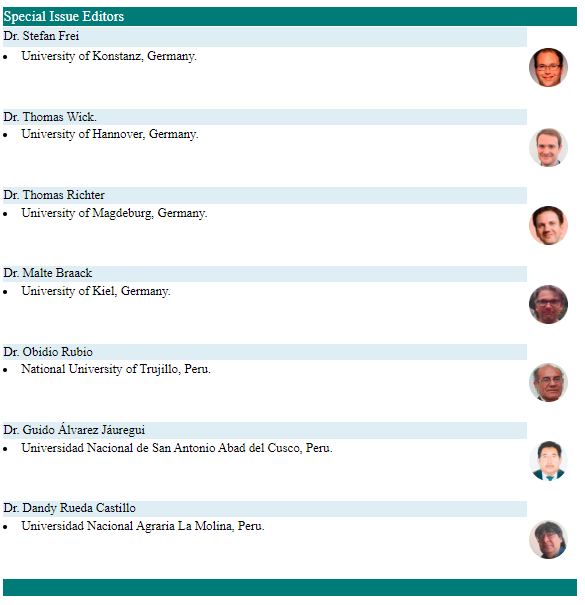Some Aspects in the PDE. The Dirichlet and the Cauchy Problems
DOI:
https://doi.org/10.17268/sel.mat.2024.01.10Keywords:
Potential, Newton, Cuachy, Nirenberg, Hörmander, Problem and principle od Dirichlet, Cauchy problemAbstract
In this article we present two classic problems in PDE: the Dirichlet problem and the Cauchy problem. Some ideas are previously discussed, such as functions and identities’s Green, and “bad positions” problems. The work of L.Nirenberg [1] is discussed in detail where some results of L.Hörmander [2] are used.
References
Nirenberg L. Uniqueness in Cauchy problems for differential equations with constant leading coefficients. Communications on Pure and Applied Mathematics. 1957;X.
Hörmander L. On the theory of general partial differential operators. 1955;94.
Lewy H. An example of a smooth linear partial differential equation without solution. Annals of Mathematics. 1957;66(1):155-8.
Plis A. Non-uniqueness in Cauchy’s problem for differential equations of elliptic type. Journal of Mathematics and Mechanics. 1960;9(4):557-62.
Plis A. A smooth linear elliptic differential equation without any solution in a sphere. Communications on Pure and Applied Mathematics. 1961;14(3):599-617.
Figueiredo D. Teoría clássica do potencial. Brasilia: Universidade de Brasília; 1963.
Greenspan D. Introduction to partial differential equations. New York: McGraw-Hill; 1961.
Epstei B. Partial differential equations, An introduction. New York: McGraw-Hill; 1962.
Hellwig G. Partial differential equations. An introduction. New York: Blaisdell Pub.Com; 1964.
Myint-U T. Partial differential equations of mathematical physics. New York: American Elsevier Publi. Comp.; 1973.
Courant R, Hilbert D. Methods of mathematical physics. vol. II. New York: Interscience Publishers; 1962.
Figueiredo D. Analise de Fourier e equac¸oes diferenciais parciais. Rio de Janeiro: IMPA. CNPq; 1977.
Aleksandrov AD, et al ANK. La matemática: su contenido, métodos y significado. vol. 2. Madrid: Alíanza Editorial; 1974.
Kline M. El Pensamiento matemático de la Antigüedad a nuestros días. Madrid: Alianza Editorial; 2012.
Ortiz A. Aspectos básicos en ecuaciones en derivadas parciales. Notas de Matemática No 3 Universidad Nacional de Trujillo. 1988.
Ortiz A. Tópicos sobre ecuaciones en derivadas parciales. Dpto Matemática Universidad Nacional de Trujillo. 2004.
Figueiredo D. O Princípio de Dirichlet. Matemática Universitaria SBM. 1985;1.
Coddington EA. An introduction to ordinary differential equations. New York: Prentice- Hall, INC; 1961.
Evans LC. Partial differential equations. Graduate Studies in Mathematics. vol. 19. American Mathematical Society; 2010.
Hörmander L. Linear partial differential operators. 1963.
Dieudonné J. History of functional analysis. North-Holland Math Studies. 1983;77.
Brézis H. Functional analysis, Sobolev spaces and partial differential equations. Universitext. Springer Science & Business Media; 2010.
Bers L, John F, Schechter M. Partial differential equations. New York: Interscience Publishers. John Wiley Sons, Inc; 1964.
Stakgold I. Green’s functions and boundary value problems. New York: John Wiley -Sons; 1979.
Egorov YV, Shubin MA. Partial differential equations I. Foundations of the classical theory. New York: Springer-Verlag; 1992.
Jost J. Partial differential equations. Graduate Texts in Mathematics. Springer - Verlag; 2002.
Jr CM. Some recent developments in the theory of partial differential equations. Bulletin of AMS. 1962;68(4).
Brezis H, Browder F. Partial differential equations in the 20th Century. 1998;Advances in Mathematics 135.
Hörmander L. Linear differential operators. Actes, Congres Intern Math. 1970;1.
Treves F. On local solvability of linear partial differential equations. Indiana: Purdue University, Lafayette; 1969.
Calderón AP, Zygmund A. On the existence of certain singular integrals. Acta Mathematica. 1952;88.
Maurin K. Methods of Hilbert spaces. Polish Scientific Publishers; 1967.
Pedersorn RN. Uniqueness in Cauchy’s problem for elliptic equations with double characteristics. Arkiv för Matematik. 1966;6(27):535-49.
Chung SY. Uniqueness of the Cauchy problem for certain quasi-linear partial differential equations. Journal of the Korea Society of Mathematical Education. 1986;25(1):33-7.
Zeman M. Uniqueness of solutions of the Cauchy problem for linear partial differential equation with characteristics of variable multiplicity. Journal of Differential Equations. 1978;27(1):1-18.
Calderón AP. Uniqueness in the Cauchy problem for partial differential equations. American Journal Mathematics. 1958;80(1):16-36.
Nirenberg L. On elliptic partial differential equations. vol. 13. Annali della Scuola Normale Superiore di Pisa; 1959.
Vásquez JM. El Problema de Dirichlet. Universidad de Panamá; 1989.
Ponce AC. II Escola de E.D. Rio de Janeiro. In: Métodos Clássicos em Teoría do Potencial; 2006.
Schwartz L. Méthodes mathématiques pour les sciences physiques. Hermann S G Paris.
;VI(115).
Mijailov VP. Ecuaciones diferenciales en derivadas parciales. Moscú: Editorial MIR; 1978.
Downloads
Published
How to Cite
Issue
Section
License
Copyright (c) 2024 Selecciones Matemáticas

This work is licensed under a Creative Commons Attribution 4.0 International License.
The authors who publish in this journal accept the following conditions:
1. The authors retain the copyright and assign to the journal the right of the first publication, with the work registered with the Creative Commons Attribution License,Atribución 4.0 Internacional (CC BY 4.0) which allows third parties to use what is published whenever they mention the authorship of the work And to the first publication in this magazine.
2. Authors may make other independent and additional contractual arrangements for non-exclusive distribution of the version of the article published in this journal (eg, include it in an institutional repository or publish it in a book) provided they clearly state that The paper was first published in this journal.
3. Authors are encouraged to publish their work on the Internet (for example, on institutional or personal pages) before and during the review and publication process, as it can lead to productive exchanges and to a greater and more rapid dissemination Of the published work.












